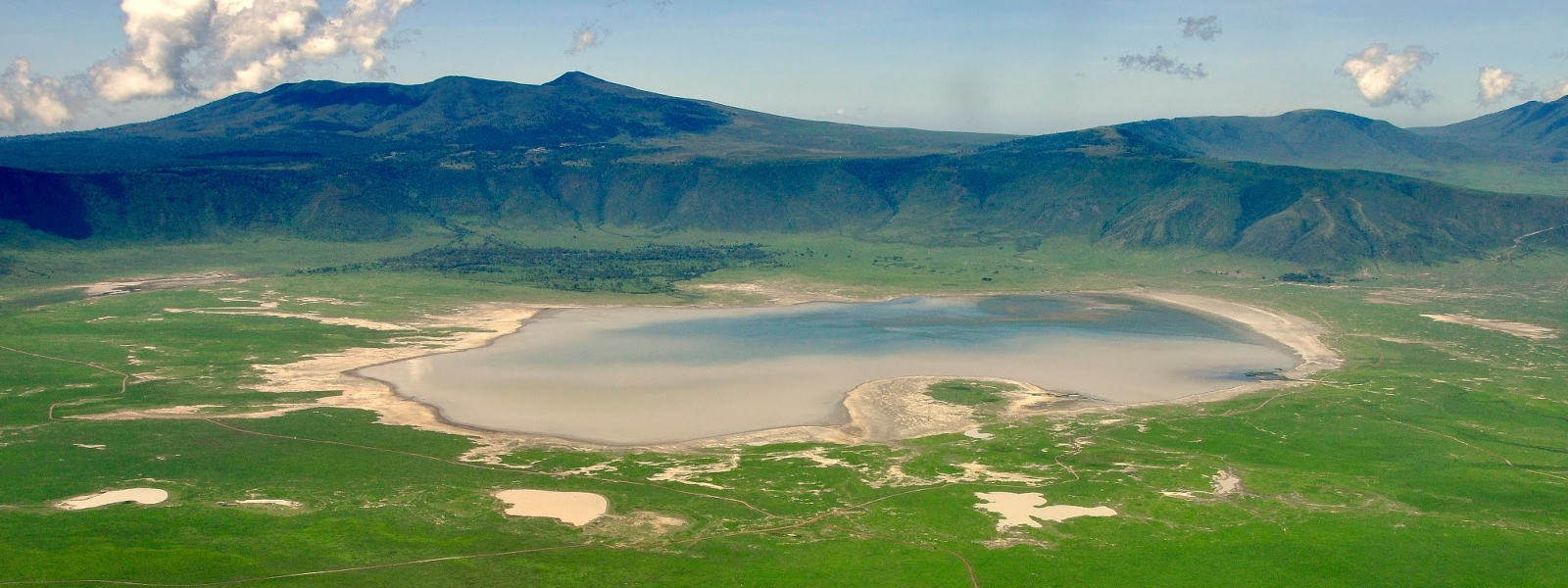Regarded as the 8th wonder of the world. Granted the status as a World Heritage Site in 1978 and an international Biosphere Reserve in 1981, it is one of the most diverse and fascinating areas of Tanzania.
The Ngorongoro Conservation Area (NCA) is home of Ngorongoro Crater. It was formed some 2.5 million years ago from a volcanic mountain sinking due to inactivity, and was initially thought to be higher than Tanzania’s famous Kilimanjaro. The crater has evolved into a unique and integral part of Tanzania’s eco-system. Also the place where you found wildlife and Maasai with their cattle.
The crater is actually a caldera, measures 21 km’s across and the rim walls stand 600m high. Views from within and from the rim are breathtaking (as can be seen from the picture). The crater houses 25,000 animals and a large variety of birds, which rarely move from the area due to the availability of water through wet and dry seasons. Black Rhinos, which are on the endangered list, can be found scattered throughout the base of the crater. Visitors are almost guaranteed to get a look at one of these spectacular animals (our personal favorite).
This is also one of the few places where the “big five” can be found in a small area, namely Elephant, Buffalo, Rhino, Lion and Leopard. For those who don’t know, the big-five were given this name due to the extreme danger and cunning these posed to early hunters. Buffalos for example, have a habit of playing dead after being shot. Once the hunter approaches to see his “kill” the buffalo rises and mauls the intended killer to death. The main water source for the animals in the crater is Lake Makat. In and around this lake are thousands of lesser flamingos. The lake is pretty much right in the center of the crater.
NCA is not a National Park, but a conservation authority administered by the government of Tanzania. Due to the diverse nature of the area the conservation authority is attempting to co-ordinate the many needs of the people accessing it. Main conservation projects include wildlife, people and culture, forestry, archaeological and prehistoric, education and obviously tourism. The area is in such demand by all the aforementioned factors, that there a definite need to manage these areas viably. Visitors are therefore requested to respect the rules laid down by authorities to preserve this naturally rich area.
A short journey from the crater will take you to one of the most famous archaeological sites, called Laetoli. Here the remarkable footprints of animals and ancestral humans who walked the earth 3.6 million years ago can be found. Along with this, at Olduvai Gorge, you can see the remarkable record of human evolution from 2 million years ago. These sites were excavated by the famous Dr Louis Leakey and his wife Mary and makes for fascinating viewing. A trip to the museum and presentation is definitely recommended.
A short trip down the road and one will encounter the “Shifting Sands”. This is volcanic sand formed into a dune, and drifts along in its exact same shape down a large plain forced forward by continuous winds. These sands have religious significance to Maasai, and its progress has been marked back as far as 1969.
The beauty of the area cannot be put into words. From ancient volcanic activity, all around one can see hills, mountains, kopjes and plains. From the rim of the crater one can see to the Southeast, Oldeani Mountain. Water collects in the mountain’s ragged crater and flows down into Lake Eyasi. On the northern side, one will come across Makarut Mountain, with Sadiman on its shoulder. Makarut can be seen as a landmark from anywhere in the Serengeti plains. Sadiman Mountain is an old volcano whose ash preserved the Laetoli footprints. Another mountain to the north is Olmoti. Rainwater is also caught in here, and feeds the Mandusi Swamp, which in turn feeds Lake Makat, in the center of the Ngorongoro Crater. From the rim of another crater called Empakaai, one can see the striking cone of Tanzania’s most recent and still active volcano, Oldoinyo Lengai. The last eruption of the volcano was in 1983. And recently it occurred a partial eruption on 2007.
As NCA is not a National Park, hiking trails are permitted in the area and range from 2 – 7 days.
Visitors often pay the ultimate compliment to Ngorongoro Crater, saying, “It’s like a zoo”. With such a large variety and amount of animals roaming freely in such a relatively confined space means the conservation efforts are working, and also indicates that there is no poaching, as animals are not afraid of human activity. This area is a must for your northern circuit safari.
Please contact us for more details should you require them.
